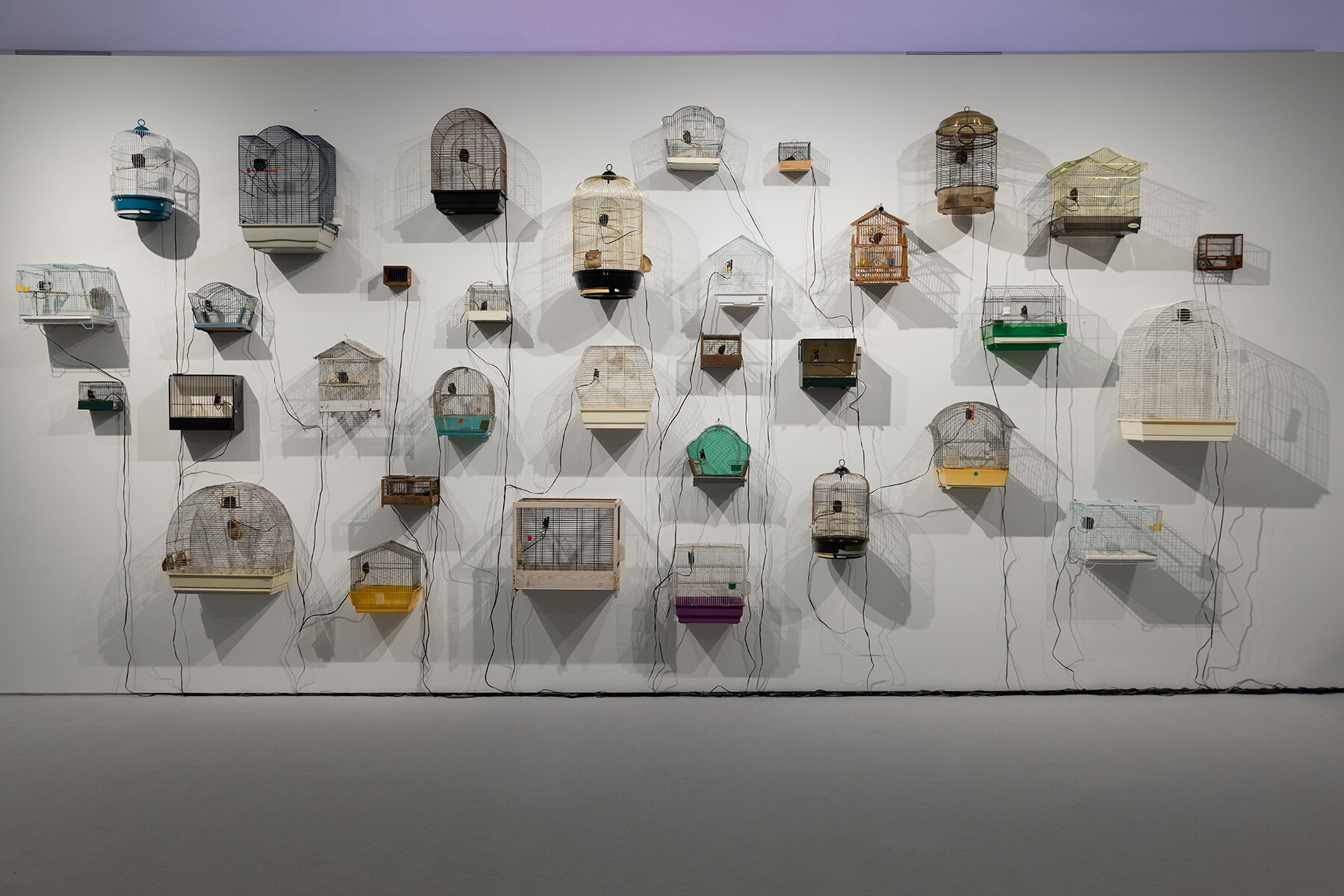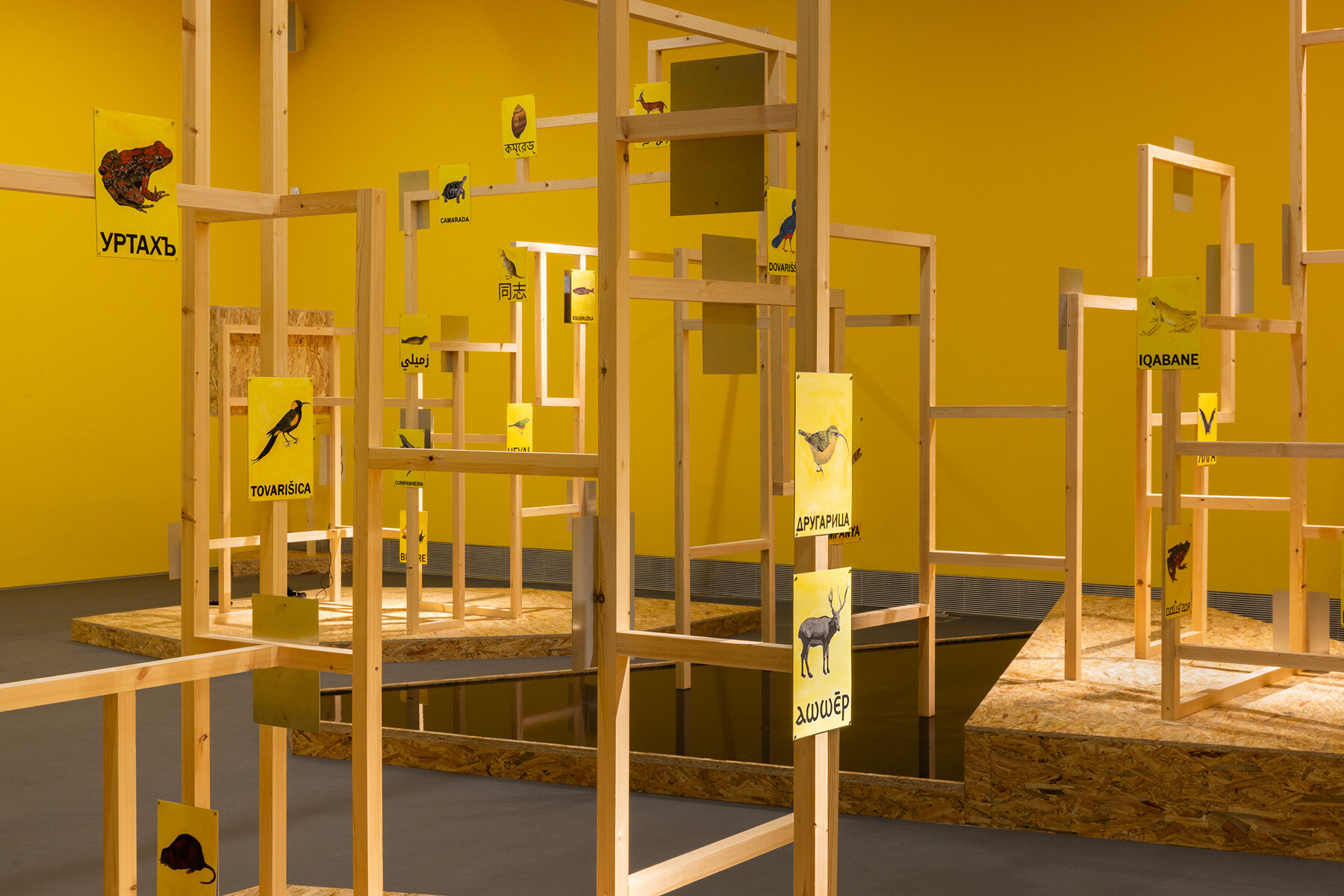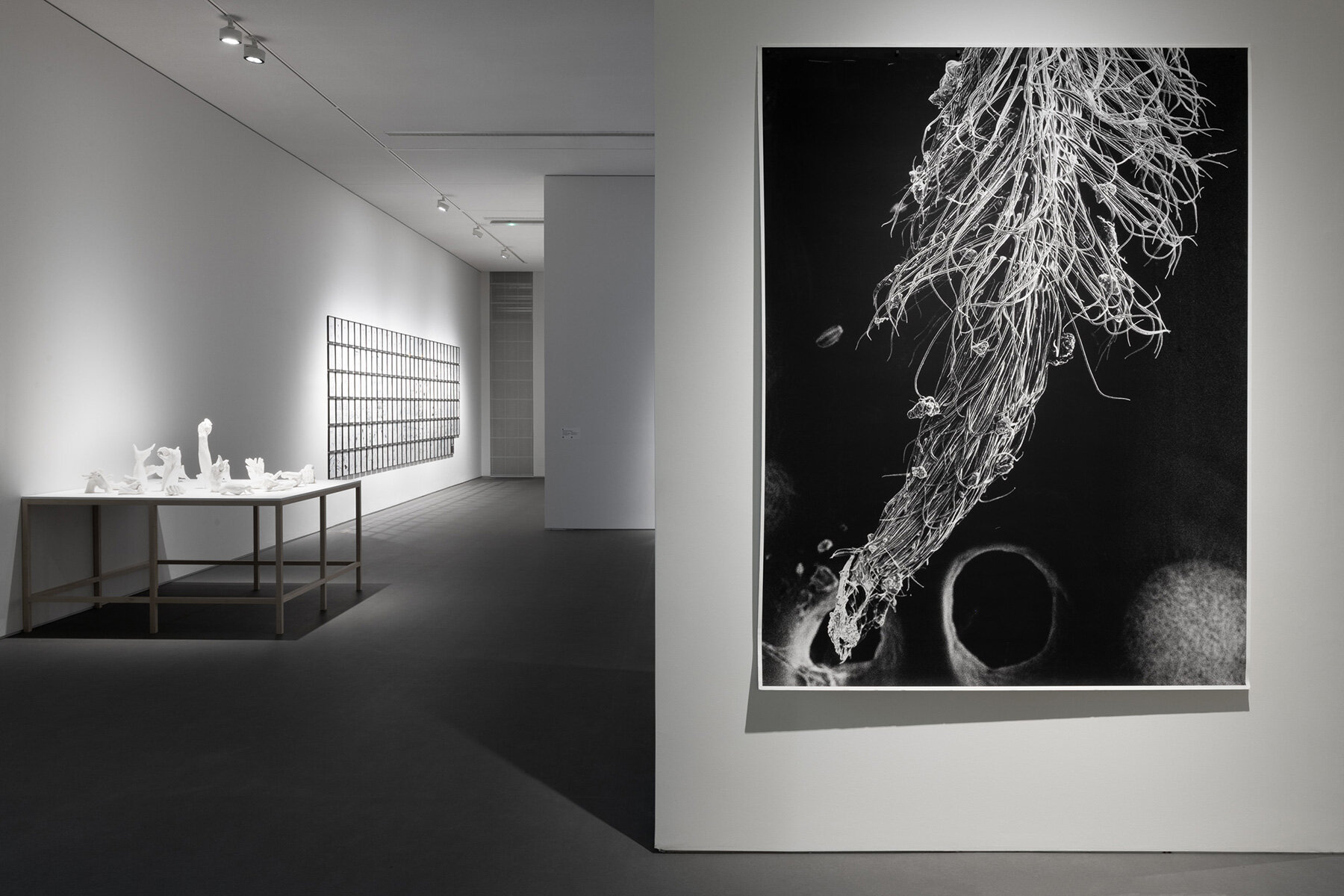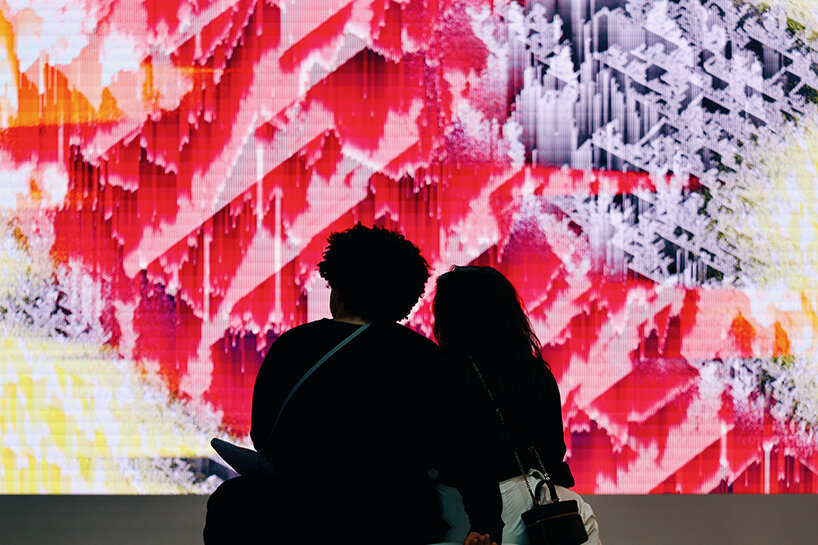emst hosts major show on animal rights and multispecies ethics
Why Look at Animals? A Case for the Rights of Non-Human Lives transforms the National Museum of Contemporary Art (EMST) in Athens into a stage for over 60 international artists grappling with one of the most urgent ethical questions of our time: how do we live with, and not over, animals?
Running until January 7th, 2026, the museum-wide show spans five floors, combining visual art, science, philosophy, and activism to challenge speciesism and advocate for animal rights, sentience, and voice. ‘At its core, Why Look at Animals? A Case for the Rights of Non-Human Lives is an attempt to shift our gaze from a purely anthropocentric worldview to one that recognises the rights, agency, and suffering of non-human beings.’ Katerina Gregos, curator of the exhibition and EMST’s creative director, explains, speaking with designboom. Inspired by John Berger’s seminal 1980 essay, Why Look at Animals? underscores the notion of ‘listening beyond language.’ It implicitly strives to ‘speak for those who have no voice,’ as the curator frames it, a driving force that shaped the entire process.

from left to right: Mark Dion, Men and Game, 1998. Courtesy of the artist and Tanya Bonakdar Gallery, New York, Los Angeles | Rossella Biscotti, Clara, 2016. Courtesy of the artist | all installation view images by Paris Tavitian, unless stated otherwise
listening beyond language: art as a site for interspecies empathy
The curatorial framework by the art historian Katerina Gregos pierces through the anthropocentric lens that has rendered animals invisible, both culturally and ecologically. ‘I’ve always felt the subject of animal rights and well–being to be an urgent one, and was puzzled how the so-called ‘art world’ did not consider it worthy of attention until very recently,’ she shares with designboom. Far from romanticising nature, the show boldly confronts the systems that exploit animal life: industrial farming, vivisection, the exotic pet trade, hunting, and entertainment. Works on view make visible the brutal disconnections of modernity, where animals have been relegated from myth, companion, and co-inhabitant to product and spectacle. Berger’s claim that animals have ‘disappeared’ from daily life is literal here – their erasure becomes the focal point of critical reflection and creative resistance.
While rooted in ethics, Why Look at Animals? also delves into science, drawing on neuroethology and animal studies to dismantle outdated ideas like Descartes’ bête-machine, the animal as automaton. ‘I’ve long been concerned with questions of injustice and inequality, particularly within the human sphere,’ Gregos tells us, adding that she ‘realised early on that they are sentient, intelligent beings who are disadvantaged in our world because they do not possess speech.’ Visitors are prompted to engage with animals as complex beings with emotional lives, intelligence, and social structures that may differ from human norms but are no less profound. Texts by thinkers like Peter Singer, Martha Nussbaum, and Tom Regan shape the theoretical spine of the exhibition, bringing together philosophical, legal, and environmental dimensions of animal advocacy. ‘This systemic disconnection from the lives and deaths of animals mirrors a broader ethical and ecological rupture, one that the exhibition at EMST seeks to confront,’ insists Gregos. In a world where animals are often framed as voiceless, this show turns up the volume, demanding a reconfiguration of how we think and live. Dive into our in-depth discussion with Katerina Gregos below.

Nikos Tranos, Terrain (bridle for horses), 2024. courtesy of the artist and Zoumboulakis Galleries, Athens | Jonas Staal, Exo-Ecologies, 2023. Commissioned by Power Station of Art l 14th Shanghai Biennale Cosmos Cinema, Shanghai. Courtesy of the artist
INTERVIEW WITH KATERINA GREGOS
designboom (DB): How did John Berger’s 1980 essay shape your vision for this exhibition? Are there particular passages or ideas from the text that served as a curatorial compass?
Katerina Gregos (KG): The title of the exhibition is drawn directly from John Berger’s seminal 1980 essay Why Look at Animals?, which was both a starting point and a conceptual anchor for the project. Berger’s reflections on the estrangement of humans from animals resonated deeply with me and informed my curatorial explorations. He begins his essay by highlighting the important role that animals played in human societies; ‘The animals first entered the human imagination as messengers and promises’ he writes, thus acknowledging the deep symbolic and spiritual role animals once played in human cultures. However, he goes on to point out a sea change in the relationship between humans and animals during modernity, highlighting the fact that ‘In the last two centuries, animals have gradually disappeared.’ This is a reference not only to extinction or physical absence but to their cultural and symbolic disappearance from human life. ‘Everywhere animals disappear’ he emphasizes, ‘In zoos they constitute the living monument to their own disappearance.’ This is a striking statement on how animals have been marginalized and isolated in modern society, especially through artificial settings like zoos or circuses where they have been reduced to a spectacle or commodity – confined to manmade spaces, such as theme parks, factory farms, and, ultimately, to the abstraction of the supermarket shelf.
This systemic disconnection from the lives and deaths of animals mirrors a broader ethical and ecological rupture, one that the exhibition at EMST seeks to confront. Berger’s idea that animals have ‘lost their centrality’ in the human imagination helped shape the curatorial vision, which does not aim to romanticise animals or nature, but rather to challenge the mechanisms – economic, cultural, and visual – through which non-human lives have been rendered invisible, disposable, or instrumentalised. The book serves as the basis for the exhibition’s ethico-philosophical approach to non-human lives, and its plea for a consideration of animal rights. It is in this spirit that Why Look at Animals? becomes not only a question, but a provocation, one that urges viewers to reconsider how we see, relate to, and live with other species.

front to back: Maarten Vanden Eynde Homo stupidus stupidus, 2008. Private collection, Slovenia | Nabil Boutros, Celebrities / Ovine Condition, 2014. Courtesy of the artist
DB: What was the most challenging aspect of curating an exhibition that seeks to raise awareness and advocate for the moral and legal consideration of non-human life?
KG: One of the most challenging aspects was finding the right balance between raising awareness and fostering critical reflection – without falling into didacticism or moralising or the trappings of simplistic agit-prop art. Art is not activism in the traditional sense; its strength lies in its ability to open up space for nuanced thinking, emotional engagement, and deeper contemplation. But when dealing with such an urgent and ethically charged subject as the rights of non-human life, the line between aesthetics, advocacy, and information is a delicate one. Another challenge was how to sensitively represent the often invisible or marginalised suffering of animals, especially those not typically granted empathy – such as lab animals, factory-farmed creatures, or those displaced by environmental destruction. How do you visualise their realities without sensationalising or exploiting their pain? How do you speak for those who have no voice? These were questions I constantly grappled with. That is why there are no taxidermied animals in the exhibition, or scenes of graphic violence.
On a practical level, assembling a constellation of works that reflected a diversity of voices, geographies, and cultural understandings of human-animal relationships was vital. It was important to resist a Western-centric narrative and instead draw attention to plural worldviews – particularly Indigenous, postcolonial, or non-Western perspectives – that often hold a much more holistic understanding of interspecies coexistence. Ultimately, the challenge was to curate an exhibition that doesn’t offer easy answers, but rather provokes questions – about ethics, responsibility, and our place in the wider web of life. I hope that Why Look at Animals? A Case for the Rights of Non-Human Lives can contribute to a broader shift in consciousness and policy, while also encouraging a personal reckoning about the assumptions we have.

front to back: Maarten Vanden Eynde Homo stupidus stupidus, 2008. Private collection, Slovenia | Nabil Boutros, Celebrities / Ovine Condition, 2014. Courtesy of the artist
DB: How does the exhibition address our uneven empathy toward animals, especially those typically overlooked or excluded?
KG: The exhibition aims to challenge the hierarchy of empathy that governs our relationships with non-human animals – where certain species are cherished, while others are ignored, commodified, or exploited without a second thought. At its core is the recognition that all forms of life are interconnected, and that our survival is deeply dependent on the well-being of the ecosystems and species with whom we share this planet. Despite having histories marked by colonialism, fascism, and struggles for independence – oppressions that should have sensitised us to injustice – we continue to uphold a deeply anthropocentric worldview. We presume human superiority over other species, often failing to acknowledge the moral and ecological consequences of that belief. This mindset not only leads to the suffering of non-human lives but positions us as one of the few species capable of destroying its own habitat.
Through Why Look at Animals? A Case for the Rights of Non-Human Lives, I hope to provoke a deeper reflection on these contradictions, and encourage viewers to reconsider the ways in which empathy is selectively applied. By bringing to light the lives and perspectives of animals we rarely think about – from those used in testing or factory farming to those displaced by extractivist practices – the exhibition seeks to foster a more just and inclusive understanding of coexistence. Empathy must be extended beyond the familiar and the lovable, to include all those whose lives are intertwined with ours – often invisibly.

the museum-wide show advocates for animal rights, sentience, and voice | image © designboom
DB: With artists from over 30 countries, how did you make sure the exhibition reflects culturally diverse understandings of human-animal relationships rather than a Western-centric view?
KG: From its inception, Why Look at Animals? A Case for the Rights of Non-Human Lives was conceived not as a Western-centric exhibition about animals in art, but as a critical, ethical, and culturally expansive exploration of human-animal relationships across different regions, histories, and worldviews. One of EMST’s core commitments is to challenge the dominant narratives that often shape large-scale exhibitions, particularly those rooted in a Western canon. In line with the museum’s mission to explore ‘creative memory practices’ and resist presentism and amnesia, the curatorial approach deliberately sought out artists whose practices are embedded in culturally specific, historically layered, and often marginalised understandings of non-human life.
The exhibition features over 200 works by 60 artists from more than 30 countries across four continents, many of whom engage with non-Western cosmologies, Indigenous perspectives, and postcolonial critiques of human exceptionalism. This diversity was not incidental – it reflects the museum’s broader aim to foreground multiple, often contradictory, ways of understanding the world, particularly those shaped by colonial histories, forced industrialisation, ecological degradation, and ongoing systems of exploitation. Moreover, EMST’s position in Athens – as a city at the intersection of Europe, the Balkans, the Middle East, and North Africa – offers a unique vantage point from which to question binary worldviews. Greece itself has a hybrid identity shaped by Eastern, Levantine, and Western influences, and the museum draws on this complexity to amplify voices and narratives that sit outside of dominant curatorial models. In this sense, Why Look at Animals? is not only about animals, but also about how different cultures relate to the living world – how they remember, mythologise, commodify, mourn, or coexist with it. It is about making space for those understandings that have been excluded or undervalued, and about using contemporary art to surface new ethical relationships with more-than-human life.

Oussama Tabti, Homo-Carduelis, 2022 (installation view), Sound installation, Bird cages, speakers, 33’ (loop), Dimensions variable, Collection of EMST
DB: Do you see this exhibition as the beginning of a larger movement within contemporary art to address the rights of non-human beings? What role should artists and institutions play going forward?
KG: Yes, I believe this exhibition is part of a growing and necessary shift in contemporary art – one that seeks to dismantle anthropocentric worldviews and take seriously the rights, experiences, and agency of non-human beings. While this conversation has existed in philosophy, science, and activism for some time, contemporary art is now increasingly engaging with it in ways that are visceral, imaginative, and politically urgent. Art has a unique capacity to visualise the invisible, to make felt what is often ignored, and to propose new modes of thinking and relating. Why Look at Animals? A Case for the Rights of Non-Human Lives contributes to a wider re-evaluation of how humans coexist with the more-than-human world – by foregrounding the ethical, emotional, and ecological dimensions of that relationship. The exhibition does not claim to provide definitive answers, but rather opens up a space for questioning, witnessing, and empathising – urging us to reconsider our own fraught and conflicted relationship with animals.
Going forward, artists and institutions alike have a responsibility to foster this kind of critical dialogue. For institutions, that means programming that reflects ecological urgency, supporting transdisciplinary approaches, and ensuring that diverse cultural perspectives on non-human life are represented – not just those rooted in Western scientific or philosophical frameworks. For artists, it means continuing to challenge dominant narratives, creating work that highlights urgent issues and how we understand them and using their practices to imagine more equitable multispecies futures. If there is a movement underway, it must also be an ethical one – grounded in care, accountability, and an openness to learn from other ways of being. The museum can – and must – be a place where such reorientations can begin.

visitors are prompted to engage with animals as complex beings with emotional lives | image © designboom
DB: In working on this project, did your personal relationship with animals or views on speciesism evolve in ways you didn’t expect?
KG: Curating Why Look at Animals? A Case for the Rights of Non-Human Lives has been both a professional and deeply personal journey. I’ve long been concerned with questions of injustice and inequality, particularly within the human sphere. But I’ve also grown up with many different animals, living side by side with them, and realised early on that they are sentient, intelligent beings who are disadvantaged in our world because they do not possess speech. I’ve always felt the subject of animal rights and well–being to be an urgent one, and was puzzled how the so-called ‘art world’ did not consider it worthy of attention until very recently. Working closely on this exhibition, immersing myself in the vast and often disturbing realities of human-animal relationships, made me confront more viscerally the structural violence and moral blind spots that underpin speciesism.
What surprised me was not so much a change of heart – I have always felt that the way humans treat animals is profoundly problematic – but rather a sharpening of perspective, an expanded sense of urgency given the ecological crisis, in which animals are the invisible victims. The research forced me to confront the sheer scale and normalisation of cruelty towards non-human lives, often hidden in plain sight. I realised just how embedded this hierarchy is in our culture and how difficult it is to disentangle ourselves from it, even when we try. The exhibition also made me reflect more consciously on the idea of co-existence – not as an abstract ideal, but as a necessary ethical imperative. It’s no longer enough to think of animals as beings we must protect out of compassion. We must start acknowledging them as subjects with agency, presence, and rights, as lives that matter in and of themselves, not just in relation to us. This shift, I believe, is one that artists and cultural institutions must support. We have to help recalibrate the ethical lens through which we look at the world, to open up space for imagining new forms of kinship and solidarity across species.

Lynn Hershman Leeson The Infinity Engine, 2014 (detail) Multimedia installation, Dimensions variable. Courtesy of the artist, Altman Siegel, San Francisco and Bridget Donahue, New York
DB: What kind of emotional or intellectual response do you hope to evoke in viewers?
KG: The exhibition confronts a range of exploitative and often invisible forms of violence against animals – whether through scientific testing, space exploration, genetic engineering, hunting, or habitat destruction driven by extractivist and industrial agricultural practices. At its core, Why Look at Animals? A Case for the Rights of Non-Human Lives is an attempt to shift our gaze from a purely anthropocentric worldview to one that recognises the rights, agency, and suffering of non-human beings. I hope the show elicits both an emotional and intellectual response: empathy, reflection, discomfort, perhaps even outrage – but also a deeper understanding of the structural and ethical failures that underpin our relationship with the non-human world.
The goal is not to provoke guilt, but to awaken awareness and a sense of shared responsibility, and an impetus to change our habits (to meat, for example). By inviting viewers to confront the systemic ways in which human actions harm animal lives and degrade shared ecosystems, Why Look at Animals? aims to build a compelling case for reimagining how we cohabit the planet. The destruction we inflict on non-human life is ultimately a form of self-harm – an expression of greed, moral failure, and a profound inability to coexist with what is simply other than ourselves. If this project can spark meaningful dialogue, raise awareness beyond the art world, and contribute even incrementally to changing attitudes or policy, that would already be a powerful outcome.

Maarten Vanden Eynde
Taxonomic Trophies, 2005 – ongoing (detail)
Branches, wood and metal name tags
Dimensions variable
Courtesy of the artist

Gustafsson & Haapoja Embrace Your Empathy, 2016/2025 (installation view) Installation, 20 Flags Dimensions variable Co-commissioned by EMSΤ Courtesy of the artists

Radha D’Souza and Jonas Staal, Comrades in Extinction, 2020 – 2021 (installation view, detail), installation with wood, hardened oil landscape and gouache paintings. Dimensions variable, Production by EMST. Courtesy of Studio Jonas Staal

the show boldly confronts the systems that exploit animal life | image © designboom

Paris Petridis Lagia, 2001; Imathia, 2006; Thessaloniki, 2021; Galilee, 2011; Dead Sea, 2012. Courtesy of the artist

(from left to right): Marcus Coates, Extinct Animals, 2018. Courtesy of the artist and Kate MacGarry, London | Simona Denicolai & Ivo Provoost, hello, are we in the show?, 2012. Collection S.M.A.K., Stedelijk Museum voor Actuele Kunst, Ghent | Anne Marie Maes, Glossa (bee tongue), 2024.

Marcus Coates Extinct Animals, 2018 (installation view, detail) Group of 19 casts, plaster Dimensions variable Courtesy of the artist and Kate MacGarry, London| image © designboom
project info:
name: Why Look at Animals? A Case for the Rights of Non-Human Lives
curator: Katerina Gregos | @katerina.gregos
venue: EMST – National Museum of Contemporary Art | @emstathens, Athens, Greece
exhibition design: Flux Office | @flux_office
dates: May 15th, 2025 – January 7th, 2026
The post ‘why look at animals?’ at EMST: katerina gregos on speaking for the voiceless appeared first on designboom | architecture & design magazine.


